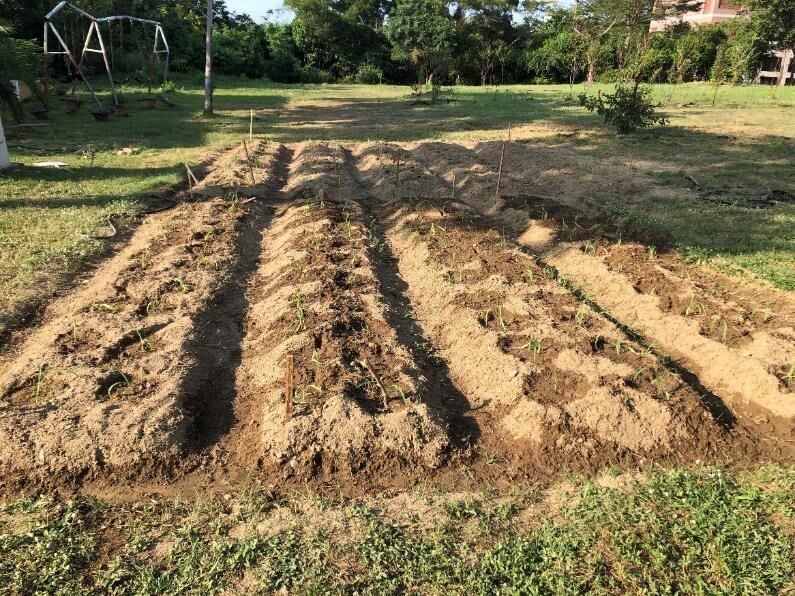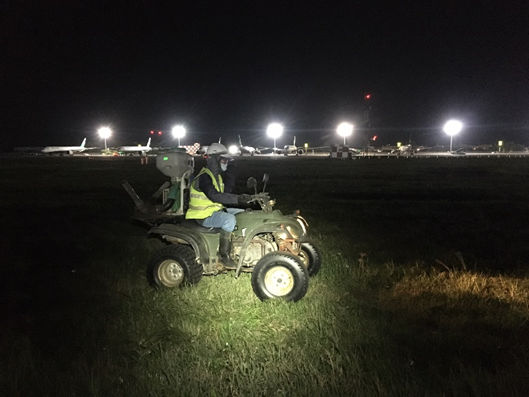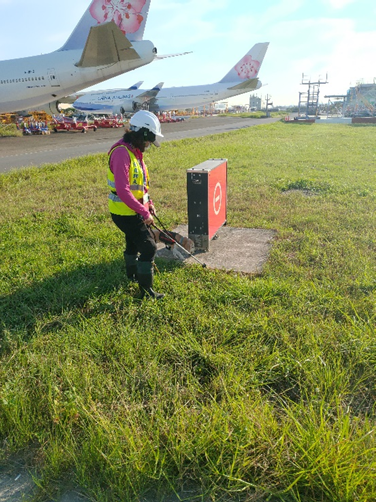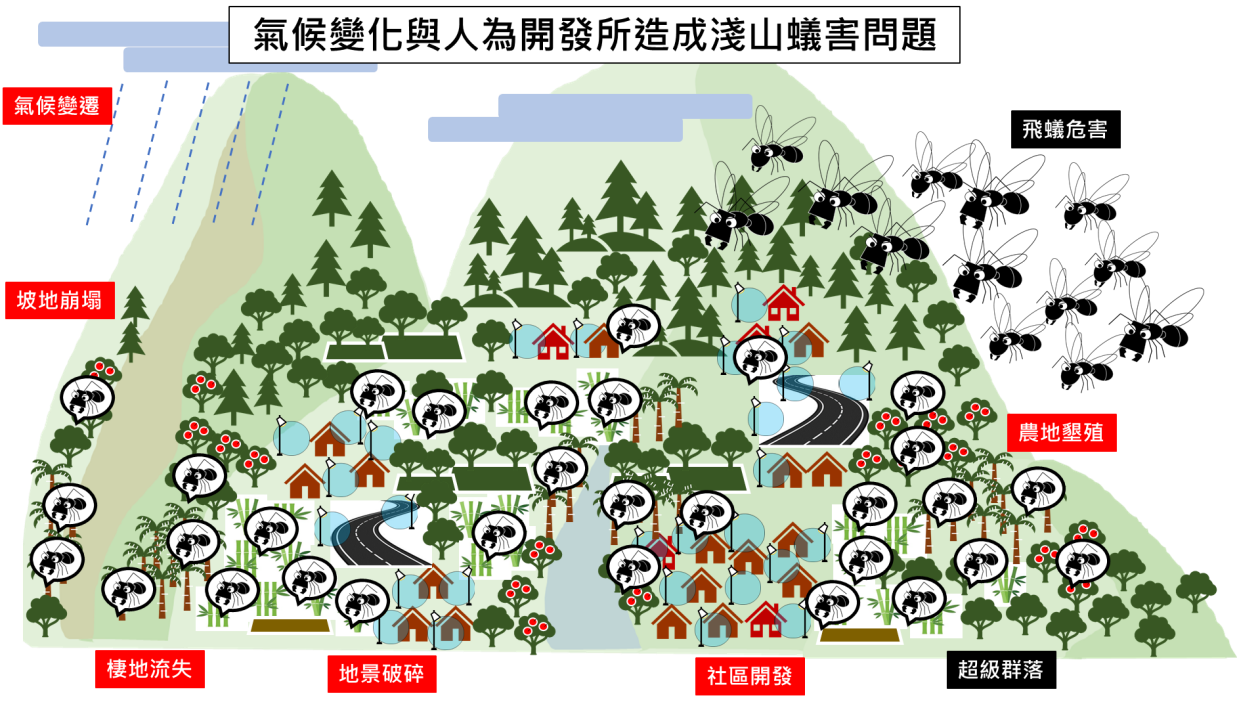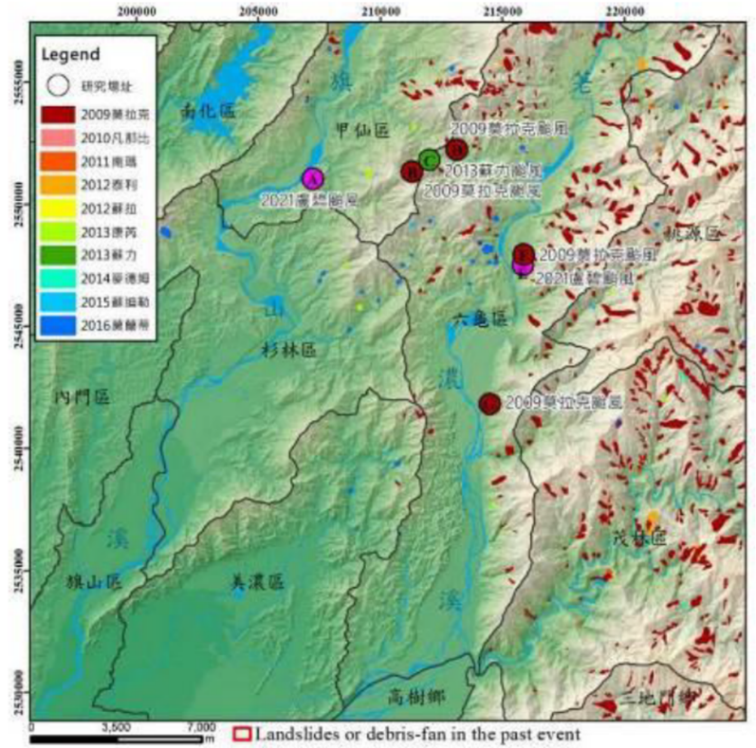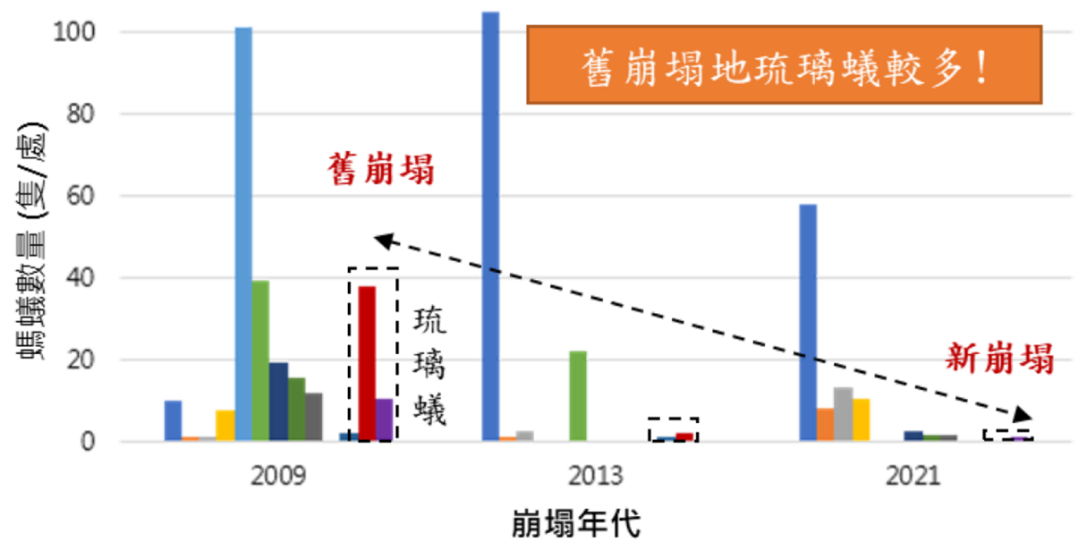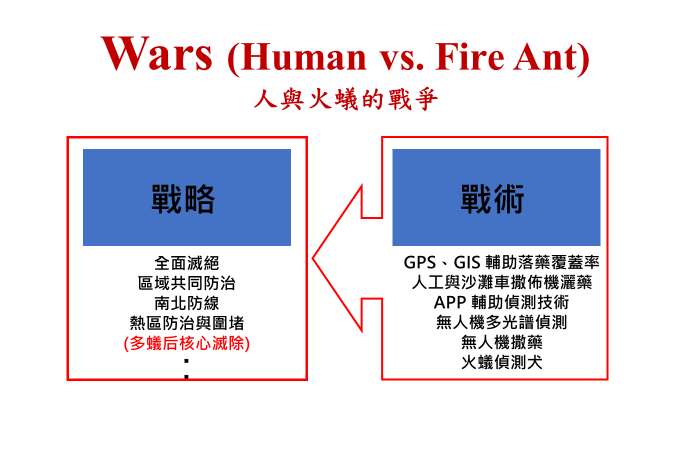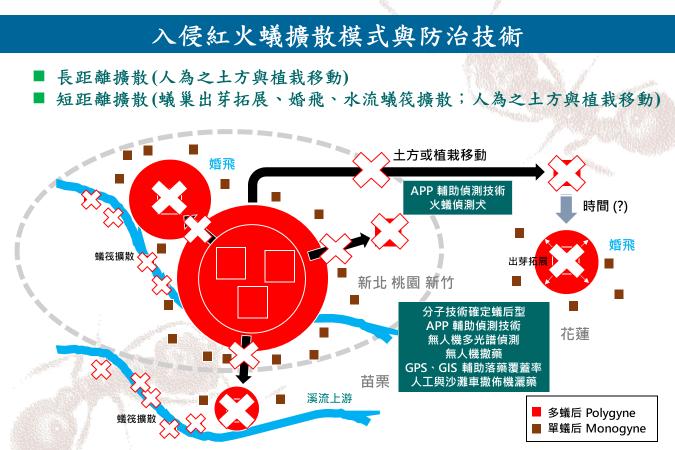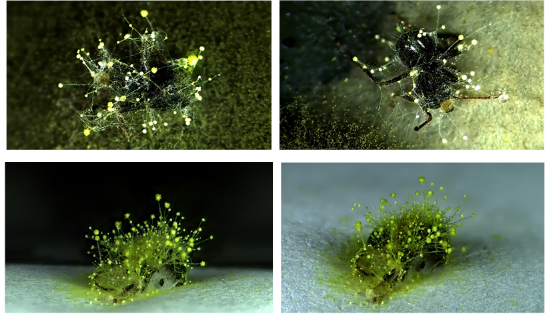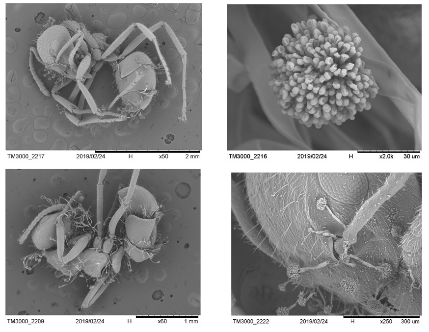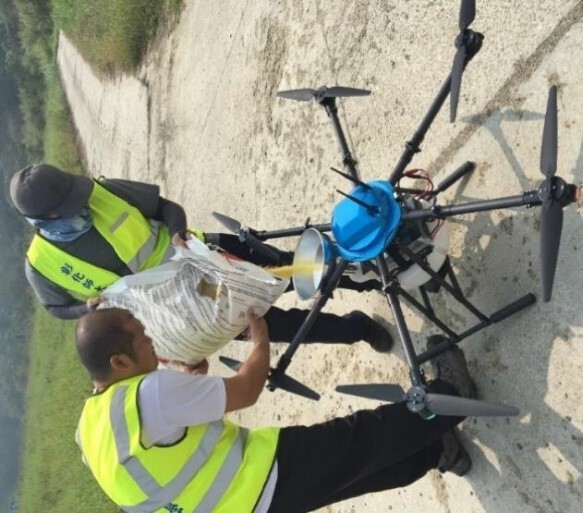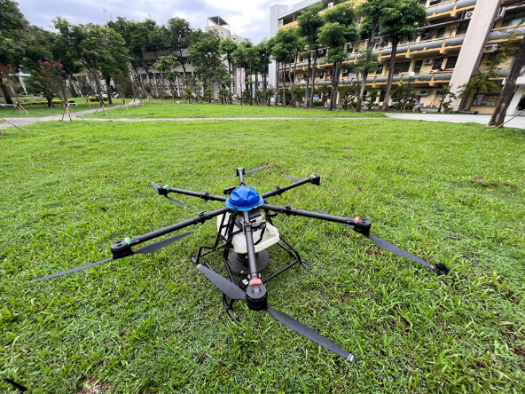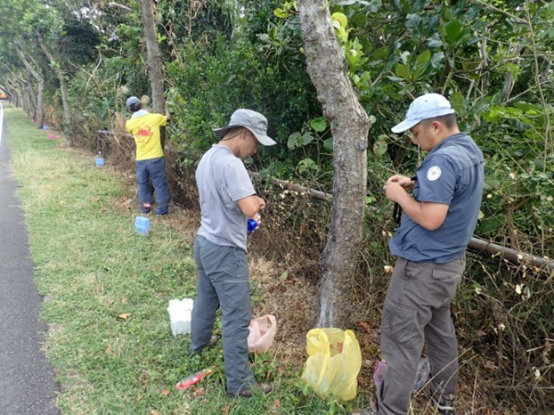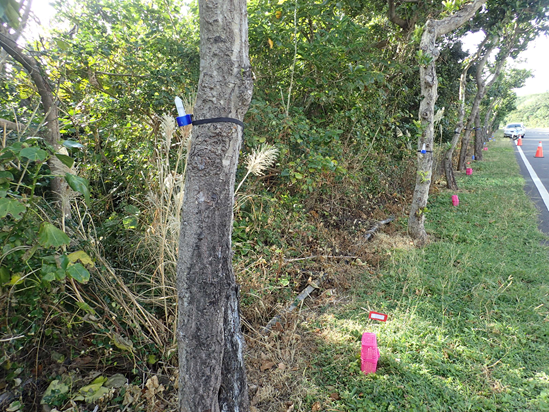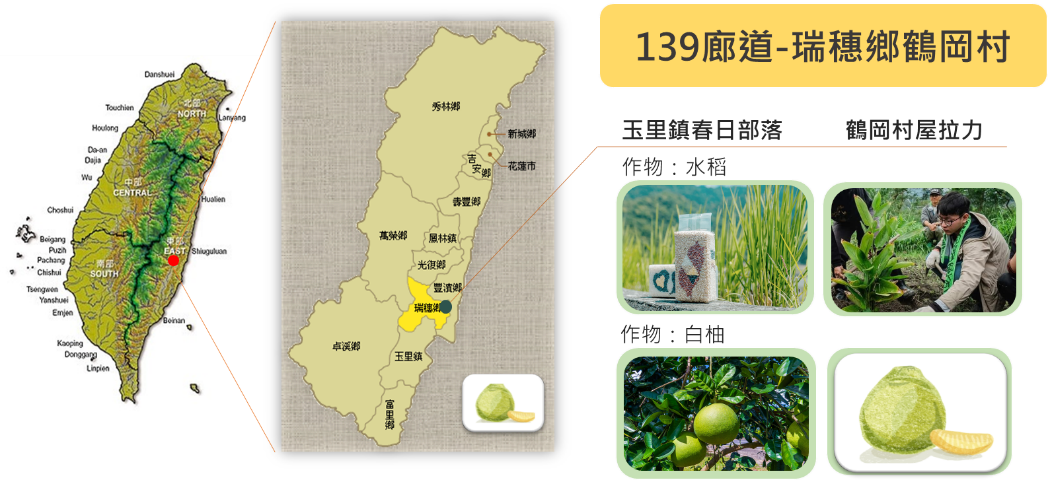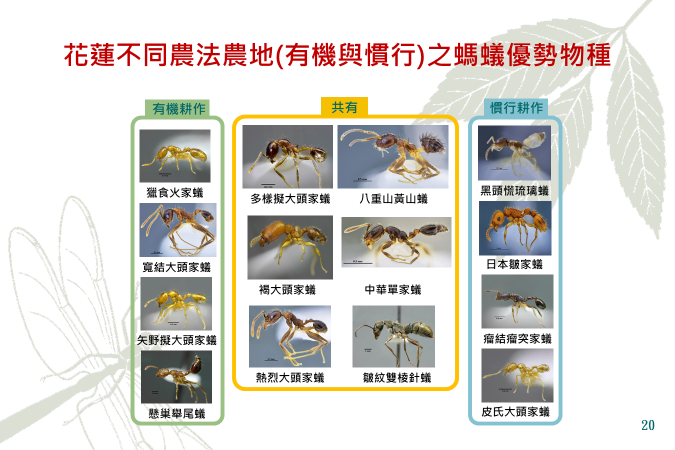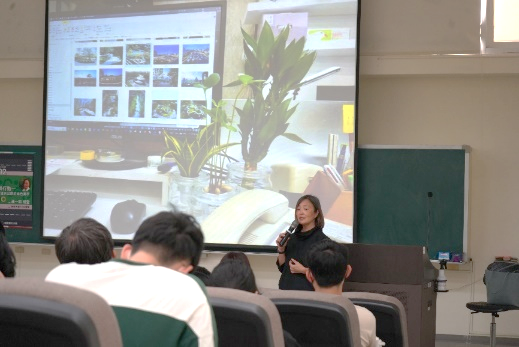SDG 15.2.1 Events about sustainable use of land
In addition to sustainable land use, National Changhua University of Education (NCUE) is involved in various other projects or activities, including the Environmental Education Centre’s “Project of Taoyuan International Airport Corporation/Entrusted Planning and Design for Red Imported Fire Ants (RIFA) Control”; Biology Department’s “Project of Ministry of Science and Technology /Discussion and Solutions to the Problem of Pest Ant Damage Caused by the Impact of Climate Change on the Lowland Ecology and the Change of the Lowland Community”, Science and Technology Division’s projects, Reshape the Prevention and Control of Global Invasive Species: Positioning Taiwan as a “Hub for the Prevention and Control, Prediction and Education of RIFA in Asia” and “Development of Microbial Control Technology of Agricultural Pest Ant”; a project of the Bureau of Animal and Plant Health Inspection and Quarantine, Council of Agriculture, “Development of Core Technologies and Establishment of Safety Assessment Model of the Agricultural Spraying Drone Industry Chain-Field Trials for Using Agricultural Drones to Control RIFA through the Management of Drone Pesticide Spraying Delegation System”, a project of the Kenting National Park, “Yellow Crazy Ant Invasion Status Investigation and Control Strategy Research in Kenting National Park”; “Field Survey on Ants in Farmland with Different Agricultural Practices”; Disaster Prevention and Information Center’s “Using LiDAR Point Cloud in the Forest and Hyperspectral Data to Analyze the Spectral Characteristics of Terrain and Build a Canopy Elevation Model”; The Center for General Education’s “Seeing and Doing - Green Aesthetics in Homes, Streets and Parks”, summarized in the following Table 1. The following section introduces the above-mentioned projects.
Table 1. Related projects and events
|
Project activities |
Subsidized units |
|
Project of Taoyuan International Airport Corporation/Entrusted Planning and Design for Red Imported Fire Ants (RIFA) Control |
Taoyuan International Airport Corporation |
|
Discussion and Solutions to the Problem of Pest Ant Damage Caused by the Impact of Climate Change on the Lowland Ecology and the Change of the Lowland Community |
Ministry of Science and Technology |
|
Development of Microbial Control Technology of Agricultural Pest Ant |
Ministry of Science and Technology |
|
Development of Core Technologies and Establishment of Safety Assessment Model of the Agricultural Spraying Drone Industry Chain-Field Trials for Using Agricultural Drones to Control RIFA through the Management of Drone Pesticide Spraying Delegation System |
Animal and Plant Health Inspection Agency, Ministry of Agriculture |
|
Yellow Crazy Ant Invasion Status Investigation and Control Strategy Research in Kenting National Park; Field Survey on Ants in Farmland with Different Agricultural Practices |
Kenting National Park |
|
Investigation, Monitoring, and Control Plan for Long-Legged Ants in Shoushan National Nature Park |
National Nature Park Headquarters |
|
Using LiDAR Point Cloud in the Forest and Hyperspectral Data to Analyze the Spectral Characteristics of Terrain and Build a Canopy Elevation Model |
Taiwan Forestry Research Institute, Ministry of Agriculture |
|
Seeing and Doing - Green Aesthetics in Homes, Streets and Parks |
|
Firstly, adjacent to the Baoshan Campus staff dormitory area, there was a vacant plot of land that was developed into an agricultural education field in 2022 (Happy Farm). This space was utilized to engage students in general education courses to grow corn and understand the significance of agricultural education. Agricultural cultivation at the “Happy Farm” follows natural farming practices, avoiding the use of pesticides and chemical fertilizers to protect the land and ecology, including water quality and insects. Related photos of these activities are shown in Figure 1.
|
|
|
Figure 1. Leading students in establishing the agricultural education area (Happy Farm) |
Second, the NCUE’s related interventions included:
1. “Project of Taoyuan International Airport Corporation/Entrusted Planning and Design for RIFA Control”:
Taoyuan International Airport is located in the Dayuan District. In 2004, Taoyuan International Airport determined that the area around Taoyuan Airport, the airport traffic lane, and some parts of the lawn that divide the running chute were invaded by RIFA. The project team has achieved remarkable results after years of prevention and control work. The entire airport area has been lifted from the list of management by the government in May 2018. However, because Taoyuan International Airport is located in the Dayuan District of Taoyuan City, and the current RIFA population distribution and density in the district is still relatively serious, the airport is still considered an area susceptible to RIFA recurrence. The goal of the project team is to continue to assist Taoyuan International Airport in the prevention and control of RIFA in the entire airport area, including manpower planning and execution in the control and investigation field operation, planning for the types of prevention and control agents, method suggestion and execution, RIFA monitoring and control rate reporting, assistance in reports required by the competent authorities, and checking related matters on RIFA prevention and control. Related event photos are shown in Figures 2-3.
|
|
|
Figure 2. NCUE Taoyuan International Airport RIFA Control Team assisting in on-site control work at Taoyuan Intl. Airport (night shift) |
|
|
|
Figure 3. NCUE Taoyuan International Airport RIFA Control Team assisting in on-site detection work at Taoyuan Intl. Airport (RIFA detection dog operations) |
Link to the video of the project:
https://www.facebook.com/NCUEEEC/videos/a.1053897732014001/549273452851485.
2. Project of the Division of Science and Technology: “Discussion and Solution Strategies on the Ant Infestation Problems in the Qianshan Caused by the Impact of Climate Change on the Ecology of Qianshan and the Changes in the Community”:
Natural disasters on slope arising from climate change and man-made development pressure have caused landscape fragmentation, ecological fragmentation, and habitat loss, causing slopes in Qianshan, an ecologically fragile area. Recently, emerging ant infestation problems became evident in Qianshan towns in south-central Taiwan. Ants pour into houses like streams, and flying ants invade homes like black mist. Such abnormal ecological responses are warnings of the gradual loss of ecological health in Taiwan. Thus, this project integrates multiple domains. It takes the ant infestation problem of the Qianshan residents as the starting point to comprehensively examine the hidden landscape fragmentation, ecological loss, and development pressure behind the ant infestation problem. Using the ecosystem service on the slopes as the research framework, this study investigates key biofacies in the habitat, analyzes landscape changes, establishes indicators, and examines environmental fragility and ecological potential. In addition, in response to the logic of the impact of the ant infestation problem on the industry and tourism in the mountain village communities, a Qianshan agricultural production system with potential for ecosystem services and human well-being have been established taking climate change as the background. Related photos are shown in Figures 4-5.
|
|
|
|
|
Figure 4. Distribution of landslides over the years in Qianshan between Laonong River and Nanzixian River, Kaohsiung City |
|
|
|
Figure 5. The relationship between damage caused by white-footed ants (Technomyrmex brunneus Forel) and landslides |
3. Project of the Division of Science and Technology: “Reshape the Prevention and Control of Global Invasive Species: Positioning Taiwan as a Hub for the Prevention and Control, Prediction and Education of RIFA in Asia”:
This study uses further data model to analyze and establish an innovative RIFA invasive platform for the ongoing scientific debate on the causes of the global RIFA invasion, making significant contributions to the prevention of RIFA, its agricultural and economic impacts, and the development of science in Taiwan. This study successfully discovered the pattern of the elimination of RIFA in Taiwan, and revealed their proliferation hotspots and paths. In addition, a smart RIFA notification platform was developed and a harmful ant detection and AI image automatic identification app system was introduced to improve the efficiency and accuracy of the detection of front-line investigators, volunteers, farmers, and the public so that the sources of infection can be detected early for prevention and control. Through geographic information system (GIS), social network analysis, and foreign and domestic RIFA distribution information, this study has made the following major discoveries: (1)RIFA are mainly distributed across general roads, rice fields, and storage. (2)The route of invasion is through ports with high shipping volumes and those having tight connections with high-shipping-volume ports. (3)The main reasons of island-type proliferation in Kinmen are due to road construction, regional construction, and city development. Therefore, a major part of this research involves assisting the Bureau of Inspection and Quarantine in distributing resources for epidemic prevention. This team has been participating in the inter-departmental meetings of the Bureau of Inspection and Quarantine. Related photos are shown in Figure 6.
|
|
|
|
|
Figure 6. Expansion mode of red imported fire ants (RIFA) and prevention technology |
References:
Link to the video of the project: https://www.facebook.com/photo/?fbid=1053897588680682&set=a.1053897732014001
Download and login process for RIFA Real-Time Detection and Reporting System app: https://apps.apple.com/tw/app/rifa/id1450106638
Project video link: https://www.facebook.com/photo/?fbid=1053897615347346&set=a.1053897732014001
4. Project of the Division of Science and Technology: “Development of Microbial Control Technology of Agricultural Pest Ant”:
The purpose of this project is the development and application of microbial control for the increasingly serious pest ants in the agricultural environment. Especially in the development of sustainable agriculture and organic agriculture, this project researches the design, development, and application of microbial agents for pest ants on crops, and it develops its practical value and commercial potential. As biological control is an environmentally acceptable strategy that can reduce the number of pest ants as well as economic losses, entomopathogenic fungus provide an environmentally friendly alternative to chemical pesticides. However, compared to pesticides, the relatively slow action of fungal pathogens hinders their wide use. The project team consists of professional academic research units and vector prevention and control management companies. In addition to the excellent research and development capabilities of academic units, the team has valuable experience in practical applications and commercial development in the industry. Fruitful academic research results can be shared with the industry to promote industrial upgrading. Moreover, the economic benefits in the market and commercial value of such technology products can be developed so that this technology can truly gain global popularity. Related photos are shown in Figure 7.
|
|
|
Figure 7. Pathogenic fungus of insects |
Link to the video of the project: https://ccource.ncue.edu.tw/files/13-1032-19022.php.
5. Project of the Bureau of Animal and Plant Health Inspection and Quarantine, Council of Agriculture: “Development of Core Technologies and Establishment of Safety Assessment Model of the Agricultural Spraying Drone Industry Chain: Field Trials for Using Agricultural Drones to Control RIFA through the Management of Drone Pesticide Spraying Delegation System”:
In areas with significant RIFA invasion, bait spreading is currently still the main prevention and control modes. However, in the RIFA prevention and control area, there are still many areas with special terrains (hills and steep slopes, rivers, valleys, fenced farmland, military control areas, etc.), where personnel and current dune buggies cannot perform control tasks. These areas are thus easily ignored. In many years, due to the terrain restrictions in many prevention and control areas, the coverage rate of prevention and control agents has only reached approximately 70-75%. Furthermore, these areas may have not been controlled for many years due to terrain factors, which results in loopholes in prevention and control and the source of the recurrence of the epidemic. Therefore, this project mainly aims to assist the establishment of the operation specifications for the use of agricultural drones in RIFA pesticide spraying on large areas or special terrains. Furthermore, the registration and management system for pesticide spraying delegation for prevention and control, through the interface for unmanned aerial vehicle spraying management data, was established. Related photos are shown in Figure 8.
|
|
|
Figure 8. RIFA control drone loaded with RIFA control bait |
Link to videos of the project: https://www.facebook.com/NCUEEEC/videos/a.1053897732014001/2572706636208601.
6. Kenting National Park Project: “Yellow Crazy Ant Invasion Status Investigation and Control Strategy Research in Kenting National Park”.
This project assists Kenting National Park in investigating the invasion of Anoplolepis gracilipes (commonly known as yellow crazy ant), one of the world’s top 100 harmful invasive species in the distribution hotspots of land crabs (Houwan, Banana Bay, Barrier Island, and Yungchuan port). Furthermore, cooperating with the Taiwanese, land crab research expert Dr. Liu Hung-Chang, used the data analysis of the number of female crabs during the breeding period when the female crabs release eggs as the sea level lowers. Dr. Liu found that the invasion of Anoplolepis gracilipes is closely related to the decline of the land crab population, which has severely impacted the survival of the native land crab population in the Hengchun Peninsula. It has also been found that in areas with high human disturbance (such as farmland, farmhouse, forest edges, or fishing ports), the number of Anoplolepis gracilipes is significantly higher. Nesting close to man-made buildings allows members in the ant nest to obtain various resources, such as food, nesting space, and irrigation water. In addition to highlighting the importance of preventing and controlling Anoplolepis gracilipes, this project also provides suggestions on prevention and control. In addition to traditional chemical control, habitat restoration and removal of objects that can be used for nesting by Anoplolepis gracilipes seem like possible control measures because they will not only increase the habitat suitable for land crabs, but also hinder the establishment of the colonies of Anoplolepis gracilipes. In view of the impact of Anoplolepis gracilipes on the ecological environment, ant control is long-term work that must be continued to reduce the probability of land crabs being “killed by ants”, thereby maintaining the biodiversity in Kenting National Park. Related photos are shown in Figure 9.
|
|
|
Figure 9. Prevention personnel and ant protection volunteers have set up yellow crazy ant bait stations in Kenting |
Link to the videos of this project: https://www.facebook.com/NCUEEEC/videos/a.1053897732014001/321681869737921.
7. Field Survey on Ants in Farmland with Different Agricultural Practices.
In recent years, the Council of Agriculture, Executive Yuan, has promoted environmentally friendly field management practices with the aim of reducing the impact of agricultural production on ecosystems and fostering sustainable agriculture. This project was conducted from November 2021 to September 2022 in different crops and farming methods, including organic and conventional rice paddies in Chunri, Yuli Township, Hualien, and organic and conventional pomelo orchards in Wulali, Hegang Village. Ant colonies were surveyed every two months using pitfall traps and Winkler bag collection methods. The final report of this project summarized the results of six surveys conducted in these areas, collecting 5 subfamilies, 29 genera, 44 species, and 5,655 ants. Diversity index analysis showed that organic rice paddies had higher Simpson’s index, Shannon’s index, and ESW index compared to conventional rice fields. In terms of ant activity and species diversity, there was no significant difference between organic and conventional rice paddies. However, in the pomelo orchards, organic orchards had significantly higher ant activity and species diversity than conventional orchards. This indicates that organic pomelo orchards have better potential in suppressing pests compared to conventional orchards. Regarding dominant species, the big-headed ant (Pheidole megacephala) was the most abundant species in both organic and conventional rice paddies. In organic and conventional pomelo orchards, the Carebara ant and the Tetramorium ant (Tetramorium sp.2) were the dominant species, respectively. These dominant species potentially play essential roles in providing ecological functions that significantly impact the ecosystem. Multivariate analysis of dominant species composition revealed that the similarity between organic and conventional rice paddies was higher than that between organic and conventional pomelo orchards. This suggests that rice paddy ants exhibit lower susceptibility to pesticide application, which can be attributed to the fact that pesticide spraying in rice paddies mainly targets the crops within the field, thereby minimizing its impact on the biota residing on the ridges. However, there was a greater difference in the composition of dominant species between organic and conventional pomelo orchards, indicating that pomelo orchard ants are more susceptible to pesticides. The species accumulation curve indicates that the distribution curve for both organic and conventional rice paddies has reached saturation, indicating that most ant species have already been collected. However, for both organic and conventional pomelo orchards, the number of species is still growing, suggesting that more species are expected to be collected in the future. This research demonstrates that agricultural production can be harmonized with biodiversity conservation. Ants, as an integral part of the ecosystem, also have the potential to provide ecological services. The ultimate goal is to achieve a social-ecological-production landscape that promotes coexistence, harmony, and sustainability between agricultural ecosystems and biodiversity. Related photos are shown in Figures 10-11.
|
|
|
Figure 10. Produce from Yuli Township, Hualien |
|
|
|
Figure 11. Dominant ant species vary in different agricultural land practices and farmland in Hualien |
8. “Using Lidar Point Cloud in the Forest and Hyperspectral Data to Analyse the Spectral Characteristics of Terrain and Build a Canopy Elevation Model”:
From the perspective of ecological functions, forest ecosystems have functional aspects such as supply, regulation, support, and culture. However, the service value of forest ecosystems is affected by changes in forest coverage or forest composition structure. Thus, the Spatial Information and Social Disaster Prevention Research Centre in NCUE was commissioned by the Forestry Research Institute to carry out this project, which integrates different advantages of multiple aerial telemetry materials and technologies in forest coverage, forest species composition, and structure investigation; and develops automated forest type interpretation models with multiple telemetry technologies. In addition, through on-site forest investigation, this project establishes the accuracy of the estimation results of aerial telemetry methods of different scales to achieve a more comprehensive forest resource investigation. The purpose is to improve the comprehensive understanding of forest resources and provide basic information on sustainable management to understand the benefits and economic values brought by forests, and then plan the protection of forest ecosystems and sustainable utilisation methods.
9. Center for General Education:
The Center for General Education offered various lectures in 2022. Information about the lecture series as listed in Table 1, and related event photos are shown in Figure 12.
Table 1. Information on general education seminars
|
Organizer (Unit)/Topic |
Date |
Number of students |
|
Seeing and Doing - Green Aesthetics in Homes, Streets and Parks |
11/2 |
90 |
|
|
|
Figure 12. Lecture poster and snapshots |
Event pictures: https://ccource.ncue.edu.tw/files/13-1032-21223.php.

